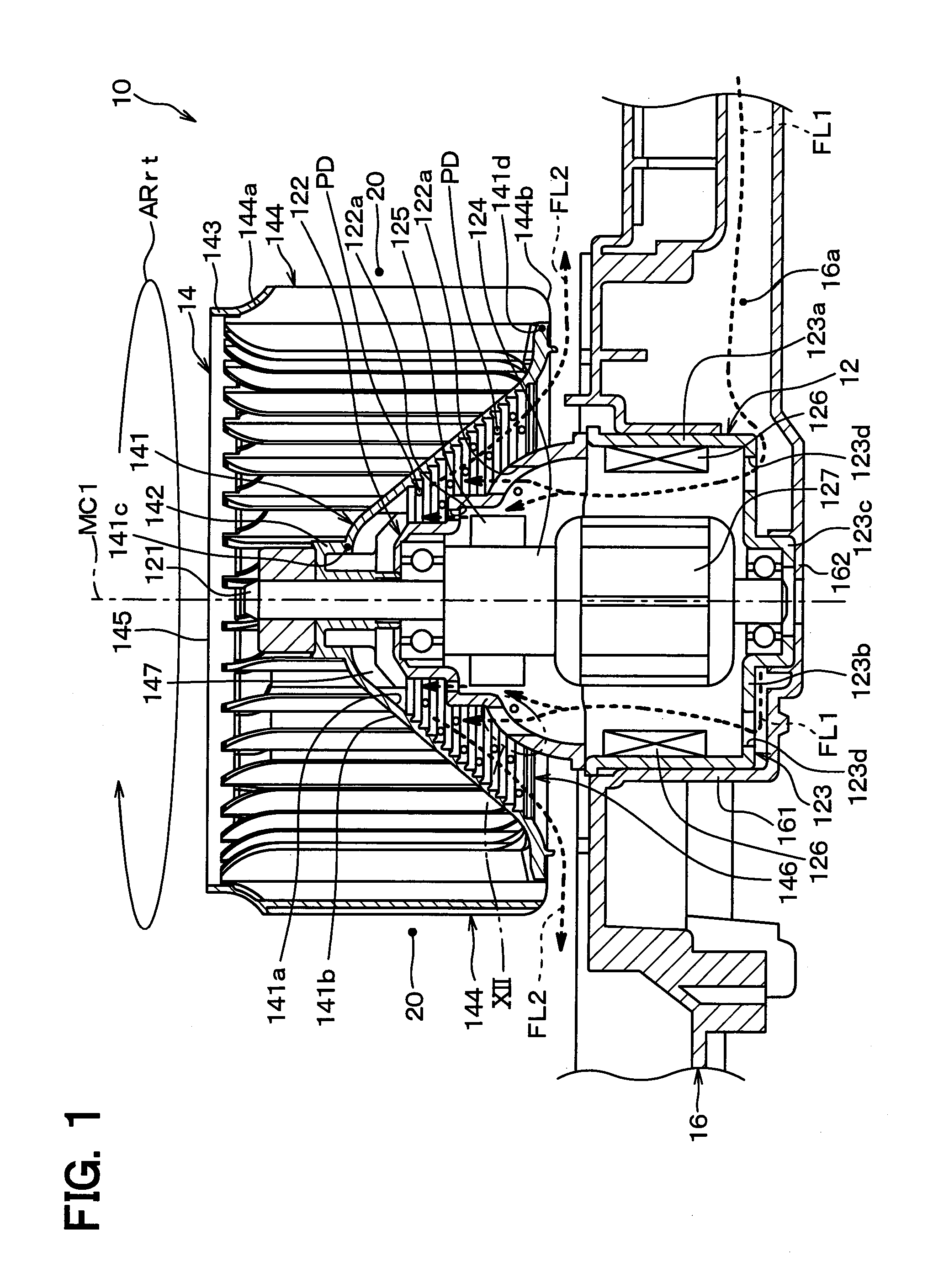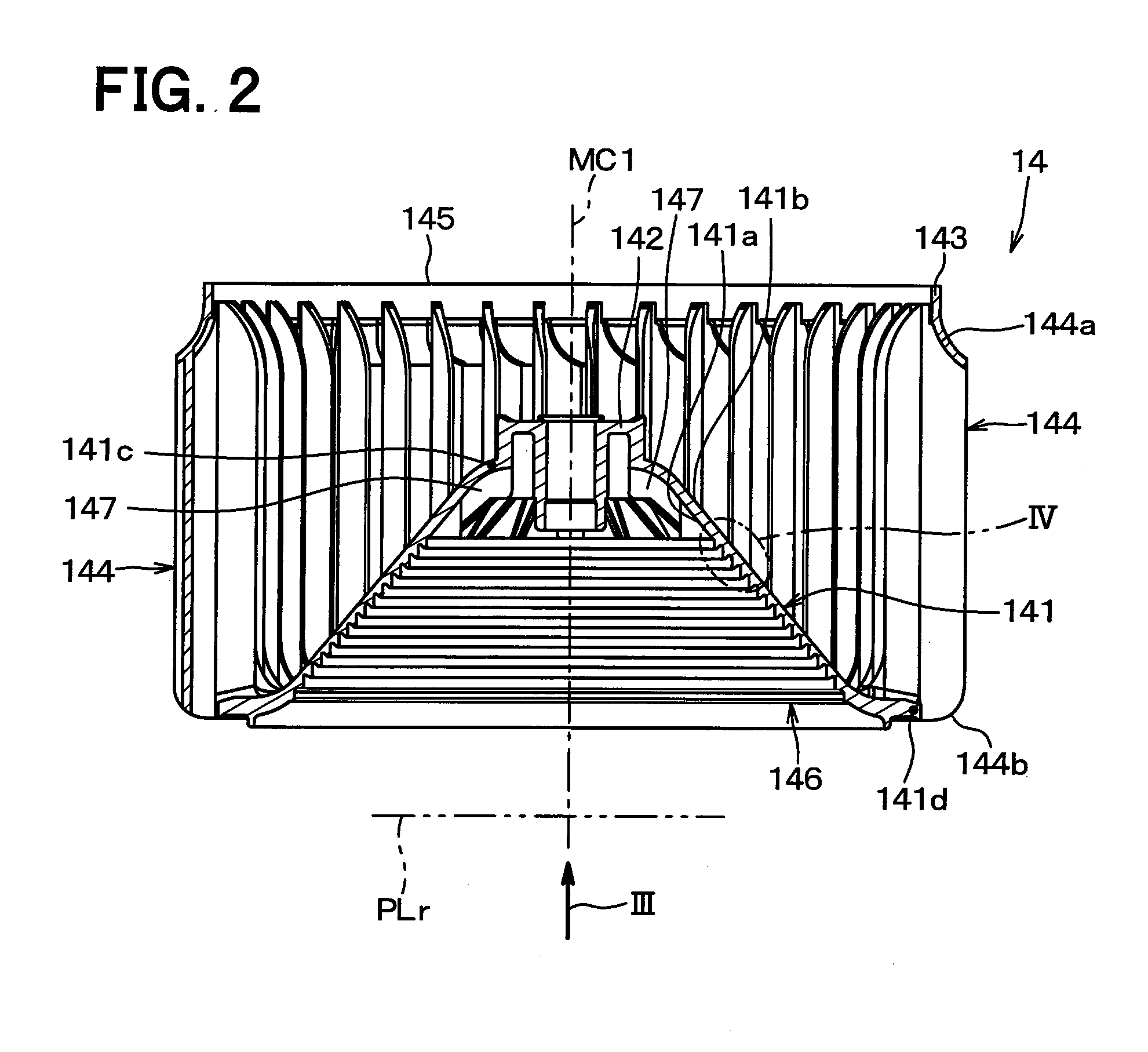Centrifugal multiblade blower
- Summary
- Abstract
- Description
- Claims
- Application Information
AI Technical Summary
Benefits of technology
Problems solved by technology
Method used
Image
Examples
first embodiment
[0027]A first embodiment is described. FIG. 1 is a sectional view illustrating an electric motor 12 and an impeller 14 of a centrifugal multiblade blower 10 (henceforth referred to the blower 10) of the first embodiment. The blower 10 shown in FIG. 1 is adopted in an air-conditioner for a vehicle, which blows off conditioned air into a passenger compartment of the vehicle, and is operated to send air for conditioning. The blower 10 is, specifically, a sirocco fan.
[0028]The blower 10 is received in an air-conditioning case (not shown) made of resin material, and an air passage through which the air-conditioning air flows is formed downstream of the blower 10 in a flow of air by the air-conditioning case. An evaporator (not shown) which cools the air-conditioning air is disposed downstream of the blower 10 in the flow of air in the air passage. Air leak is prevented by a seal material made of rubber around the evaporator. In FIG. 1, one-point chain line MC1 represents a motor axial ce...
second embodiment
[0068]A second embodiment is described. In this embodiment, a point different from the first embodiment is mainly explained, and explanation of a portion the same or equal to the first embodiment is omitted or simplified. This is the same in the third embodiment and the subsequent embodiments mentioned below.
[0069]FIG. 5 is a view in which the impeller 14 of the blower 10 of this embodiment is seen in the arrow direction III of FIG. 2, and corresponds to FIG. 3 of the first embodiment. In this embodiment, the number of the radial ribs 147 of the impeller 14 adjacent to the electric motor 12 is reduced, compared with the first embodiment, which is easily understood by comparing FIG. 5 with FIG. 3. This is the point different from the first embodiment, and the other portion is the same as the first embodiment. Concretely, the number of the radial ribs 147 in this embodiment is eight as shown in FIG. 5.
[0070]Therefore, according to this embodiment, compared with the first embodiment, t...
third embodiment
[0071]A third embodiment is described. A point different from the first embodiment is mainly explained.
[0072]FIG. 6 is a view in which the impeller 14 of the blower 10 of this embodiment is seen in the arrow direction III of FIG. 2, and corresponds to FIG. 3 of the first embodiment. As shown in FIG. 6, in this embodiment, the uneven part 146 on the main plate 141 of the impeller 14 has plural connection ribs 148 which connect the adjacent protrusion parts 146a in the motor radial direction. This is the point different from the first embodiment, and the other portion is the same as the first embodiment.
[0073]As shown in FIG. 6, eight of the connection ribs 148 extend radially in the motor radial direction. In detail, as shown in FIG. 7 and FIG. 8, each of the connection ribs 148 is formed to project toward the electric motor 12 in the main plate 141, and is formed so that the amount of projection, i.e., rib height, may not exceed the top part 146d of the protrusion part 146a. FIG. 7 ...
PUM
 Login to View More
Login to View More Abstract
Description
Claims
Application Information
 Login to View More
Login to View More - R&D
- Intellectual Property
- Life Sciences
- Materials
- Tech Scout
- Unparalleled Data Quality
- Higher Quality Content
- 60% Fewer Hallucinations
Browse by: Latest US Patents, China's latest patents, Technical Efficacy Thesaurus, Application Domain, Technology Topic, Popular Technical Reports.
© 2025 PatSnap. All rights reserved.Legal|Privacy policy|Modern Slavery Act Transparency Statement|Sitemap|About US| Contact US: help@patsnap.com



